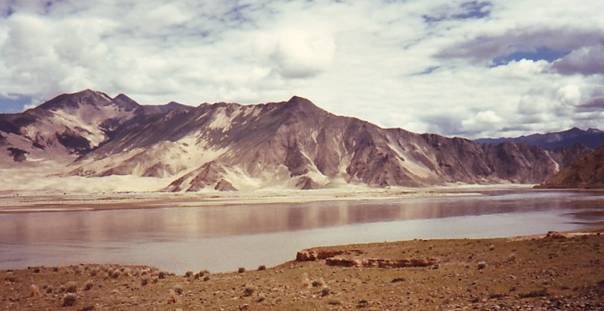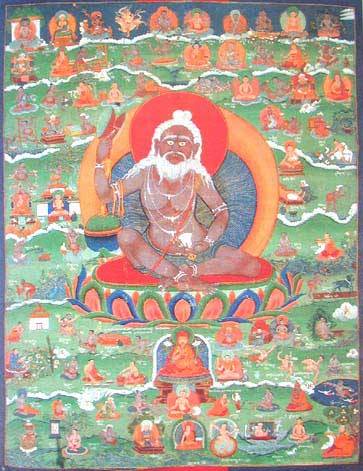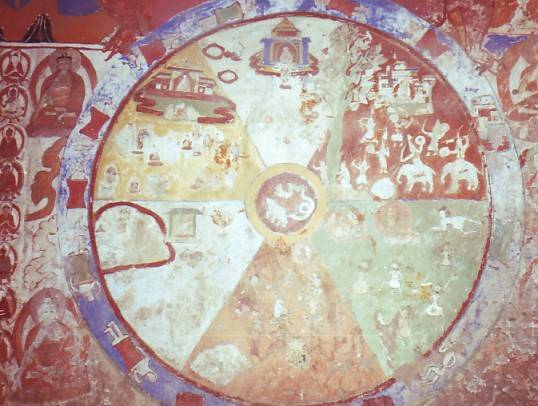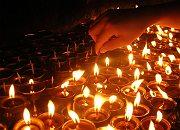| [26]

Venerable Khenchen Thrangu Rinpoche
Cultivating Compassion and the Mind of Awakening
Before speaking about the stages of meditation that were taught by the great Indian master Kamalashila, I wish to thank you for regarding this occasion as very important. I will begin by offering a supplication to the Lineage Masters. Please listen with faith and confidence in the Buddha and the Dharma.
In Tibet we have both the Sutra and Tantra Traditions. The stages of meditation that Acharya Kamalashila explained in the text he wrote, entitled, Bhavanakrama, are mainly those of Sutra.

In the 7 th century, King Songtsen Gampo ruled in Tibet; later, Trisong Detsen ruled. Both caused the teachings of the Buddha to develop and flourish in Tibet. King Detsen invited the Indian master Shantarakshita, who has come to be known as the Bodhisattva Abbot, to come to Tibet. He accepted the king’s invitation and established the Buddha’s teachings newly. Having disseminated the teachings, Shantarakshita entered nirvana. Not long before dying, Shantarakshita foretold what would happen in the future. He said:
“I have planted the authentic Buddhadharma in Tibet. However, in the future there will be trouble for the Buddhadharma in Tibet. Generally, when there is trouble for the Buddhadharma, it comes from those who are not Buddhists, but that is not what will happen in Tibet. The trouble will come from someone who is a Buddhist but who will speak falsely. When trouble comes, you should invite my student Kamalashila, who lives in India. He will quell the troublemaker, which will allow the authentic Buddhadharma to remain for a long time.”
In accordance with the prophecy that the great Abbot Shantarakshita made, a man named Hwashang Mahayana came from China to Tibet to teach the Dharma. The Dharma that he taught was a little different from the Dharma taught by the great master Shantarakshita. Hwashang Mahayana said that just as black clouds cover space and the sun, so white clouds also cover space and the sun. Also, just as when a black dog bites, the bite causes pain and hardships, so when a white dog bites, the bite wounds and causes pain too. The two dog bites are the same in that way. Similarly, both nonvirtuous thoughts and virtuous thoughts obstruct clear seeing. Therefore, one should remain without any thoughts at all. Hwashang Mahayana said that this was the main point.
When Hwashang Mahayana taught this slightly different Dharma, everyone became confused. They did not know how to practice the Dharma. They did not know how to enter the paths, and as a result trouble arose. When the king realized that trouble had come to those who practiced Dharma, he convened a meeting to determine what would remedy the situation. At the meeting, one of the great Abbot Shantarakshita’s students reminded the assembly of the prophecy that Shantarakshita had given before he passed into nirvana. Since things had come about as foretold, the Tibetans invited Kamalashila to come to Tibet, just like Shantarkshita had told.

When having come to Tibet, Kamalashila met Hwashang Mahayana for the first time along the banks of the Great Tsangpo River and thought, “If he has knowledge, we can meet in debate. If he is a fool, we cannot meet in debate.” In order to see whether or not Hwashang Mahayana had knowledge, Kamalashila circled Hwashang Mahayana’s head three times with a stick, thereby posing the question, “From what cause do the three realms of cyclic existence arise?” Because Hwashang Mahayana had great knowledge and good qualities, he understood the gesture that Kamalashila made and withdrew his hands inside the sleeves of his robe, thereby replying, “The three realms of cyclic existence arise from the ignorance that conceives of the apprehended and the apprehender.” In dependence upon that, Kamalashila knew that Hwashang Mahayana possessed knowledge and
that they could meet in debate. Thereafter, people gathered for the debate at the Glorious Samye Monastery.

The king, a witness, Kamalashila, and Hwashang Mahayana were sitting together and the king placed one garland of flowers in the hands of Kamalashila and another in the hands of Hwashang Mahayana. The king then said, “Two systems of Dharma have arisen: the Dharma of sudden realization and the Dharma of gradual realization. Because of that, people have become confused about how to practice the Dharma. To clarify that confusion, please debate. When you have debated, the loser should, without pride, offer his garland of flowers to the victor. Then, whoever loses should leave Tibet and return to his own country.” Then they debated.
Kamalashila asked questions and defeated Hwashang Mahayana. Having lost, Hwashang Mahayana offered his garland of flowers to Kamalashila and returned to China. Beginning from then, the tradition of Dharma taught by the great Abbot Shantarakshita and by Kamalashila has held sway in the snowy land of Tibet.
After that, King Trisong Detsen said to Kamalashila, “You have seen the trouble that arose here. SO that the teachings of the Buddha not be afflicted similarly in the future, please compose newly a good treatise that is easy to understand and of great benefit.” In response to the King’s request, Kamalashila newly composed the threefold text known as The Stages of Meditation, which consists of the First Treatise on the Stages of Meditation, the Intermediate Treatise on the Stages of Meditation, and the Final Treatise on the Stages of Meditation. Thus, these treatises were composed newly in order to help people when the teachings of the Buddha were initially being established in Tibet. Now, because the teachings of the Buddha are beginning to flourish in Europe and America, I thought it would be helpful if I were to present these teachings, which are not like others.
Kamalashila returned to Tibet two more times. However, there are some who debate this. For instance, in the account of Kamalashila’s life given in the edition that I am using, it is said that Kamalashila did not return to Tibet again. Rather, the author of the introduction maintains that Hwashang Mahayana hired four Chinese men to kill Kamalashila and that indeed they did kill him. However, I think that Hwashang Mahayana was a great Bodhisattva who taught Dharma and that he did not in any way arrange the murder of Kamalashila.
Some people doubt that Kamalashila returned to Tibet, and there is a basis for their doubt. When Kamalashila left Tibet, he went to India. On his way to India, he came across the corpse of an Indian man who had died of a contagious disease. Nobody dared come near the corpse. Kamalashila wanted to help the people of the area, so his consciousness moved to the corpse, walked it to a distant place, and dumped it there. His consciousness came back to the place where he had left his own body. However, in the meantime, an Indian siddha named Padampa Sangye, who had a very ugly body, came across Kamalashila’s body, which was very handsome and free from illness. He thought, “This body of mine is not good. That fresh corpse is good and handsome. I would like my consciousness to move into that body.” His consciousness then moved into the body of Kamalashila and he walked off, leaving his own body behind. When Kamalashila’s consciousness returned, the only body around was the ugly corpse of the Indian siddha, into which the consciousness of Kamalashila had to enter. Thus, the mind was Kamalashila’s but the body was not.

Kamalashila came to Tibet twice in the body of Padampa Sangye. In that body, he disseminated gChöd, the pacification practice by means of cutting through. Kamalashila’s Stages of Meditation on the Middle Way and the practice of pacification through cutting attachment are, in terms of their meaning, the same. Since the person who taught them is the same, it is not surprising that the meaning of these practices is the same.
The story that I have recounted to you is told in Karma Chakmay’s Mountain Dharma. It does not accord well with the account given by the author of the introduction to the edition of Kamalashila’s text that I am using. I believe that it is probably as Karma Chakmay has reported and for that reason I have presented it to you as he does.
Generally speaking, the First Treatise on the Stages of Meditation covers three topics: 1) the need for compassion, 2) the need for the mind of awakening, and 3) the need for bringing this into experience through practice. The first thing taught is the importance of compassion. The Buddha himself stressed the important of compassion. In what Sutras did he express this? In the Sutra of Compiling the Dharma Correctly, in the Sutra Taught by Akshayamati, and in the Hill of the Gaya Head Sutra. The Buddha said, “Anyone who has one quality can become a Buddha. What is that one quality? Compassion.”
Then Kamalashila writes about the manner of cultivating compassion. Knowing that compassion is important, we want to know the method for generating compassion in our continuum and the way to cultivate it. The way to do this is to consider sentient beings who are in pain. If we take many sentient beings to mind and consider their pain, great compassion will arise. For that reason, this treatise explains how to think about the pain that sentient beings experience.
What is the way taught here for considering sentient beings who are in pain? One considers the way in which the six types of wanderers suffer. I understand that some of you have studied the Buddhadharma for a long time and that some of you have not studied the Buddhadharma very much. Those of you who have not studied the Buddhadharma will be astonished to hear about the six types of wanderers. Therefore, I will speak about them in accordance with the way they are spoken of in the text.

First, sentient beings born in hells suffer greatly from heat, cold, and so forth. Similarly, sentient beings born as hungry ghosts suffer greatly from hunger and thirst. Also, sentient beings born as animals experience much suffering, such as eating one another, becoming angry with one another, harming and killing one another, and being misused by human beings. If one thinks about such suffering, compassion for sentient beings who take birth as hell beings, hungry ghosts, and animals will arise.
Similarly, human beings have many kinds of suffering. Some human beings are put into prison. Some are destitute. Some are enslaved by others. Thus, they are not actually hell beings, but their sufferings are similar; they are not hungry ghosts, but their suffering is similar; and they are not actually animals, but their suffering is similar. One thinks in that way about the sufferings that human beings experience. Some human beings are wealthy and comfortable. However, that wealth and comfort does not last a very long time. Not being able to enjoy wealth and comfort for a long time, in the end suffering comes to them too. When one thinks about the suffering that they experience, compassion arises.
The demigods suffer from continual jealousy of and warfare with the gods of the desire realm. As for the gods, though comfortable temporarily, later they fall down into painful situations and then suffer greatly. Similarly, even the gods of the form and formless realm cannot just stay there. When their time has been spent, they fall down to the states of hell beings, hungry ghosts, animals, humans, and so forth and suffer greatly. Therefore, sentient beings born in the states of the six wanderers have nothing but suffering. If one thinks about it, compassion can arise. In contemplating sentient beings who are suffering, one thinks, “If I had to undergo that suffering myself, I could not endure it.” In that way, one generates compassion for others by imagining oneself to be in their position.
After that, one thinks about the suffering of friends, relatives, and loved ones and cultivates compassion for them. When one can meditate well in that way, one thinks about ordinary people – those who are neither friends nor enemies – and cultivates compassion for them. When that goes well, one thinks about one’s enemies – those who harm one. Realizing that they too have suffering, one develops compassion for them. In that way, compassion is increased more and more greatly. When one can generate compassion for one’s enemies to the same degree as one has compassion for one’s friends, then one must cultivate such compassion for all sentient beings in all ten directions.
Meditating in that way, the main thing is to develop compassion for all living beings, as if they were equal, rather than for some and not for others. For instance, one may have compassion for human beings but not for non-humans. Or one may have compassion for human beings one considers belong to “us” but not for those belonging to “them.” Such compassion is not genuine and will not benefit oneself or others. If one only has partial compassion, then one will help some sentient beings but harm others. Compassion that accords with Dharma is not like that. In the perspective of such compassion, all sentient beings are as if equal. If one has compassion for all sentient beings, that is the principal among all types of compassion, and it is superior compassion. That is the first topic, the way to meditate so as to develop compassion.
The second topic is the way to meditate so as to develop the mind of awakening. How does one do this? When one has developed compassion for all sentient beings, one feels that one must be of some use to them. If one helps others with temporary things, generally it is useful and good. However, if one helps others with food, clothing, wealth, medicine, and so forth, it only helps for a short while. When those things are used up, those people suffer again. In the light of that, what will really help? Enabling sentient beings to enter into the excellent Dharma will really help, because by way of the excellent Dharma they can achieve the final fruition, the rank of a Buddha, so that in the end they will not have to suffer at all. Such an attitude, which is the effect of compassion, is thinking, “I must protect all sentient beings from suffering by establishing them in the rank of a Buddha.” That mind is the mind of awakening. If compassion arises in a genuine way, the mind of awakening will arise naturally.
There are two methods for cultivating the mind of awakening. What are the two? The first is that a Guru, who is our spiritual friend and upon whom one relies, teaches about the mind of awakening, speaks about its good qualities, and says, “It would be good if you were to give rise to the mind that aspires to supreme awakening. In fact, you must give rise to the mind that aspires to supreme awakening.” Having reflected his teachings, one gives rise to a mind that aspires to supreme awakening. That is the first way of giving rise to the mind of awakening and it is a good way. The second is to begin by giving rise to compassion. Then the mind of awakening will arise naturally. The first way is good, but the second way is very stable and powerful. Therefore, the best ways to give rise to the mind of awakening is in dependence upon great compassion.
The mind of awakening is important and beneficial. Lord Buddha himself explained this with an example. When a diamond is broken into pieces, it is still much better than ornaments of gold. Similarly, even if one is not actually able to put the mind of awakening into practice, due to having it as one’s motivation, one’s virtue will surpass the virtue of Shravakas and Pratyekabuddhas, “hearers and solitary realizers.” Therefore, the Buddha said that the mind of awakening is important.
Similarly, in another Sutra Lord Buddha said that although the merit of the mind of awakening has no form, if the merit of the mind of awakening did have form, it would fill all of space and would still exceed even that. The mind of awakening has that measure of benefit.
What minds of awakening are there? The mind of awakening has to aspects. What are the two aspects? There is the mind that aspires to awakening and the mind that enters into the activities that lead to awakening. The mind of aspiring to awakening thinks, “May I be able to accomplish the welfare of sentient beings. May I be able to establish all sentient beings in the rank of Buddhahood.” Making effort for the sake of that is the mind that enters into the activities that lead to awakening. Those are the two aspects.
I will stop here for now and invite you to ask any questions that you would like to ask.
Questions & Answers
Question: It has been said by some scholars that Hwashang Mahayana did not leave Tibet. They say that he remained in Tibet and had something to do with the arising of the Dzogchen teachings. Could you comment on that?
Rinpoche: Some people do say that, but to say that is to criticize Dzogchen, because it is saying that Dzogchen is like the system of Hwashang Mahayana, and these are words that refute Dzogchen. Some say that Hwashang Mahayana lost one of his boots when he left Tibet and that through that condition a little bit of his view is present in the Dzogchen teachings of the Nyingmapas. Actually, that is not so, and to say it is to criticize Dzogchen.
Question: You said that incomplete or partial compassion could harm people. How is that?
Rinpoche: Suppose I have compassion for one group and not for anther group. If the two groups fall into disharmony, then I will take sides with the group for which I have compassion and I will feel hatred for the group for which I do not have compassion. For instance, if someone wants to harm a friend for whom I have compassion, then I will hate that person who wishes to harm my friend. In dependence upon that hatred, I will do what I can to harm him or her. In response, that person will harm me. Partial compassion is the cause for such behaviour.
Question: Are the six types of wanderers merely psychological states? You mentioned that in the human realm there are psychological states comparable to the hell realm, hungry ghost realm, animal realm, and so forth. If they are not psychological states, where are the hell realms and god realms, and what are the beings there like?
Rinpoche: The six types of wanderers are not just mind. Generally speaking, they have form. In Vasubandhu’s Treasury of Higher Knowledge, the Abhidharmakosha, it is said that hell beings and hungry ghosts are mostly under the ground of Jambudvipa, which is to say, in the ground. The gods of the desire realm, the form realm, and the formless realm are in the sky. Therefore, it is probably like that. For instance, scientists say that within the earth there is fire. Some say that there are sentient beings there.
Question: Why is Hwashang Mahayana’s doctrine false? Both black clouds and white clouds cover the sun. If we go to the bad migrations, they are painful. If we take birth in the upper realms, they provide temporary happiness. Therefore, we must abandon all three realms of cyclic existence and achieve liberation. How does that differ from Hwashang Mahayana’s tradition?
Rinpoche: Generally, Hwashang Mahayana’s thought is not some terrible thing. However, if we refute the value of virtue suited to the occasion, then people will not be able to practice virtue. If people are not able to practice virtue, meditation will not be able to increase to a higher level. In dependence upon that, saying that it is not good to refute the value of appropriate virtue, Kamalashila refuted Hwashang Mahayana. Refuting the value of virtue does not lead to much good. It is in dependence upon our accumulation of virtue that our meditation increases to a higher level. In dependence upon one’s meditation increasing to a higher level, one achieves the rank of a Buddha. Kamalashila said that although the happiness of humans and gods is generally not very stable, to achieve liberation gradually it is important to have the body of a human as a support. To achieve the life of a human, one needs to practice virtue. In Hwashang Mahayana’s system, compassion is only temporary virtue and must be destroyed. Kamalashila held that one must cultivate both compassion and the mind of awakening. Hwashang Mahayana held that one must destroy both compassion and the mind of awakening, so in this view one must destroy everything. That was the point that they debated.
Question: I have heard that human beings have the unique ability to experience all of cyclic existence. Is there a connection between that and our ability to hear and practice the Dharma? If not, what is it that makes birth as humans an unusually good situation?
Rinpoche: Kamalashila’s text explains that humans experience situations that are similar to those of bad migrations but are not identical to them. For instance, human beings who have been put into prison are not hell beings but experience something similar to a hell. Also, human beings who are poor are not hungry ghosts but experience something like the poverty of hungry ghosts. However, it does not say that human beings experience the actual suffering that hell beings or hungry ghosts experience. Thus, human beings experience something like the suffering of hell beings, but compared to the suffering of actual hell beings, human beings have little pain. Similarly, human beings experience something like the suffering of hungry ghosts, but compared to the suffering of actual hungry ghosts, human beings have little pain. As human beings we have achieved the opportunity to practice Dharma. Hell beings and hungry ghosts have not achieved this opportunity. That is the difference between our situation and theirs.
Question: What about the sentient beings in the higher realms? What prevents them from hearing and practicing the Dharma?
Rinpoche: They are extremely comfortable and therefore are not able to feel discouragement with cyclic existence. Because they never feel discouraged with cyclic existence, they cannot generate the wish to enter into the Dharma. In dependence upon that reason, they have no opportunity to practice the Dharma.

May the life of the Glorious Lama remain steadfast and firm.
May peace and happiness fully arise for beings as limitless (in number) as space (is vast in its extent).
Having accumulated merit and purified negativities, may I and all living beings without exception
swiftly establish the levels and grounds of Buddhahood.

This article was translated and edited by Jules Levinson from Light of Berotsana in 2002 and arranged and edited slightly for the Karma Lekshey Ling Institute by Gaby Hollmann in 2007.
Photo of Padampa Sangye courtesy of the Himalayan Art Resources. Photos of the mural of The Seven Gifted Monks at Samye Monastery, the sacred complex, and the Great Tsangpo River at the crossing to Samye in Tibet taken by gh in 1986; mural of the six wanderer’s planes of existence taken in Alchi, Ladakh by gh in 1984. May virtue increase!

|